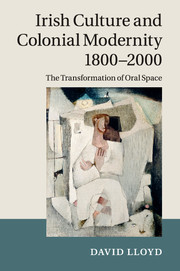Introduction
a history of the Irish orifice
Published online by Cambridge University Press: 07 October 2011
Summary
This is the loop, the pole
Bread travels along.
We have these mouths
damage stretches.
John Wilkinson
With the remarkable consistency that suggests that they are distorted forms of knowledge, stereotypes of the Irish cluster around the things we do with a single orifice, the mouth. They turn on what goes into and what comes out of that singularly labile orifice, and does so to excess. We drink too much and talk too much, at times even too well: we sing and we blather, bawl as we brawl and wail as we grieve. Given to verbal play, we excel in invective; rumour still circulates more rapidly than the daily press, just as subversion was fanned by word of mouth and the Republican ballad. But excess is counterpointed by lack: we starve in the Famine and hunger-strike in prison, and at times relapse into an ambiguous and melancholy silence. Irish silence and the Irish smile – the closed mouth and the disingenuous grin – are construed as dissimulating, subversive, unstable. The paradoxes proliferate: ‘stretched by damage’, Irish mouths are injured by mental and physical privation but they are, for all that, the loose-lipped organs of excess, subversion and an often counterfactual cultural resistance. The history of this Irish orifice is that of multiple attempts to discipline it, taming its excesses and regulating its disrespect for the proper spaces and times of speech and performance, ingestion and utterance. It is the history of attempts ‘to control a strange bodily economy in which food, drink, speech, and song are intimately related’. But it is also the history of the living on of an unruly oral space even in the very architectures and disciplines of modernity, from the pub to the prison cell, and of its resistance to the effort to contain it.
The present book is about a range of Irish bodily practices, about the formation and disciplining of the Irish body at disjunctive but subterraneously intersecting moments. But while it analyses a certain set of bodily practices, it does so through the one that is uniquely privileged in relation to the Irish, the mouth. The mouth organizes the perception and articulation of the Irish body to an unremarked but nonetheless striking extent, as for psychoanalysis the penis organizes psychic comportment both temporally and in terms of the spatial distribution of the apperceived body. Likewise, and like the penis in its symbolic status as the phallus, the mouth performs a double role, being the site simultaneously of actual practices and of symbolizations through which the motions and functions of the other members or organs are endowed with meaning. Thus, for example, it is obvious that Irish violence has always been associated with Irish drinking and Irish rhetoric, whether invective or subversive speech. The flying fist and the loose lip are an inseparable couple. Less apparently, however, Irish violence is already an effect of the oral space whose recalcitrance to modern disciplinary institutions was always coded as unruly and insubordinate. Even before it erupted as an act considered violent, Irish orality appeared from the perspective of the colonial state to be a manifestation of violence that determined how specific Irish practices were read.
- Type
- Chapter
- Information
- Irish Culture and Colonial Modernity 1800–2000The Transformation of Oral Space, pp. 1 - 18Publisher: Cambridge University PressPrint publication year: 2011



